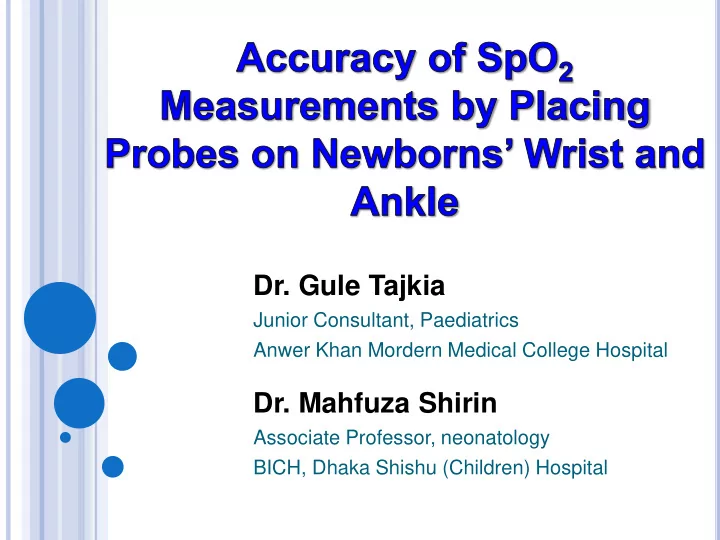

Dr. Gule Tajkia Junior Consultant, Paediatrics Anwer Khan Mordern Medical College Hospital Dr. Mahfuza Shirin Associate Professor, neonatology BICH, Dhaka Shishu (Children) Hospital
INTRODUCTION Pulse oximeter arterial oxygen saturation (SpO 2 ) has become the "fifth vital sign" in the examination of every newborn and infant with respiratory distress, besides temperature, pulse, respiration and blood pressure. Pulse oximetry is noninvasive, easy to use, is accurate and and allows continuous monitoring and is the preferred method of oxygen monitoring in neonate. .
INTRODUCTION The accuracy of pulse oximetry reading may be related to the site of pulse oximeter probe placement; but this may be difficult in sick neonate. In neonates, palm and sole are commonly used site for probe placement.
OBJECTIVE To evaluate the accuracy of pulse oximeter oxygen saturation (SpO 2 ) from probe placement at wrist and ankle as alternate of palm and sole in neonates.
METHODOLOGY Study Type : Cross sectional Study Study Period : December’ 2012 to March’ 2013 Study Place : SCABU Dhaka Shishu (Children) Hospital Sample Size : 169 neonates
METHODOLOGY Inclusion criteria: 1. Age – up to 28 days 2. Both Sex 3. Both term and preterm neonates Exclusion criteria: 1. Core body temperature <35 0 C 2. Neonate is in shock 3. Neonate getting ionotrop at high dose ( Dopamin/Dobutamine ≥ 10µg/kg/min) 4. Neonate with multiple congenital malformations
METHODOLOGY Two (2) pulse oximeters were used for simultaneous paired SpO 2 measurements The SpO 2 was measured - at 0 sec - at 30 sec - at 1 min Over the palm and ipsilateral wrist, both side Over the sole and ipsilateral ankle, both side
METHODOLOGY Statistical Analysis Two-tailed, Student’s t-tests done for analysis of continuous, normally distributed variables. Regression analysis performed to determine the relationship between paired SpO 2 measurements. The mean and standard deviation of the paired SpO 2 differences (bias and precision) calculated by Bland-Altman analysis.
R ESULTS
TABLE 1: BASELINE CHARACTERISTICS OF THE STUDY PATIENT Characteristics (n=169) Mean ± SD Range Age(days) 7.7±6.277 1-27 Gestational Age (week) 36.7±3.9 28-42 Male Gender(%) 53 Birth weight (gm) 2530.7±772.2 1000-3600 Length (cm) 46.7±3.9 37-51 OFC (cm) 32.9±2.7 25-36 Temperature (°F) 98.5 ± 0.7 98 - 102 Heart rate (per Min) 133.1 ± 17.1 100 - 190 Respiratory rate (per min) 53.4 ± 12.4 34 – 78 Capillary refill time (sec) 2.4 ± 0.4 2 – 4
T ABLE 2: C LINICAL FINDINGS OF THE STUDY PATIENT Signs/Symptoms Present Percent Nasal flaring 38 22.5 Grunting 30 17.8 Chest indrawing 70 41.4 Cyanosis 13 7.7 Pallor 46 27.2 Jaundice 34 20.1 Oedema 32 18.9
T ABLE 3: C ONCOMITENT TREATMENT IN STUDY PATIENT Procedures Frequency Percent Phototherapy 32 18.9 Oxygen 103 60.9 Ionotrops 34 20.1 Respiratory support 4 2.4
T ABLE 4:S P O 2 MEASUREMENT FROM DIFFERENT SITES Site of SpO 2 Mean ± SD Range Measurements Right palm 96.98 ± 1.52 92.66-99.33 Right wrist 96.91 ± 1.65 92.00-99.33 Left palm 96.98 ± 1.59 90.66-99.66 Left wrist 96.93 ± 1.61 90.00-99.33 Right sole 97.40 ± 1.46 92.00-99.33 Right ankle 97.51 ± 1.40 92.33-99.00 Left sole 97.58 ± 1.55 92.66-99.66 Left ankle 97.02 ± 1.58 91.66-99.33
TABLE 5: CORRELATION OF MEAN SPO 2 Site co-efficient (r) P value Correlation 0.92 < 0.0001 Right palm versus right wrist 0.88 <0.0001 Left palm versus left wrist 0.90 <0.0001 Right sole versus right ankle 0.98 <0.0001 Left sole versus left ankle
TABLE 6: RESULT OF BLAND-ALTMAN ANALYSIS Site Mean difference (Bias) ± SD of difference (precision) Right palm mean SpO 2 - right wrist 0.08 ± 0.65% mean SpO 2 Left palm mean SpO 2 - Left wrist 0.05 ± 0.79% mean SpO 2 Right sole mean SpO 2 - right ankle - 0.11 ± 0.63% mean SpO 2 Left sole mean SpO 2 - left ankle 0.56 ± 0.32% mean SpO 2
2.0 1.5 +1.96 SD Rt Palm Mean SpO2 - Rt Wrist Mean SpO2 1.35 1.0 0.5 Mean 0.0 0.08 -0.5 -1.0 -1.96 SD -1.19 -1.5 92 94 96 98 100 102 Mean of Rt Palm Mean SpO2 and Rt Wrist Mean SpO2 Bland-Altman plot of difference between SpO 2 measured at right palm and right wrist
1.5 +1.96 SD 1.13 1.0 Rt Sole Mean SpO2 - Rt Ankle Mean SpO2 0.5 0.0 Mean -0.11 -0.5 -1.0 -1.96 SD -1.34 -1.5 92 94 96 98 100 102 Mean of Rt Sole Mean SpO2 and Rt Ankle Mean SpO2 Bland-Altman plot of difference between SpO 2 measured at right sole and right ankle
1.5 +1.96 SD 1.19 1.0 Lt Sole Mean SpO2 - Lt Ankle Mean SpO2 Mean 0.5 0.56 0.0 -1.96 SD -0.07 -0.5 -1.0 92 94 96 98 100 102 Mean of Lt Ssole Mean SpO2 and Lt Aankle Mean SpO2 Bland-Altman plot of difference between SpO 2 measured at left sole and left ankle
2 +1.96 SD 1.6 1 Lt Palm Mean SpO2 - Lt Wrist Mean SpO2 Mean 0 0.1 -1 -1.96 SD -1.5 -2 -3 -4 -5 90 92 94 96 98 100 102 Mean of Lt Palm Mean SpO2 and Lt Wrist Mean SpO2 Bland-Altman plot of difference between SpO 2 measured at left palm and left wrist
CONCLUSION There was a good correlation between SpO 2 measured at the palm versus the wrist and between the sole versus the ankle. There was also a good agreement between paired SpO 2 measurements from these sites. So the wrist and ankle can be used as alternative sites to measure SpO 2 in neonates in place of the routinely used palm or sole.
Recommend
More recommend